Page 20 of 498
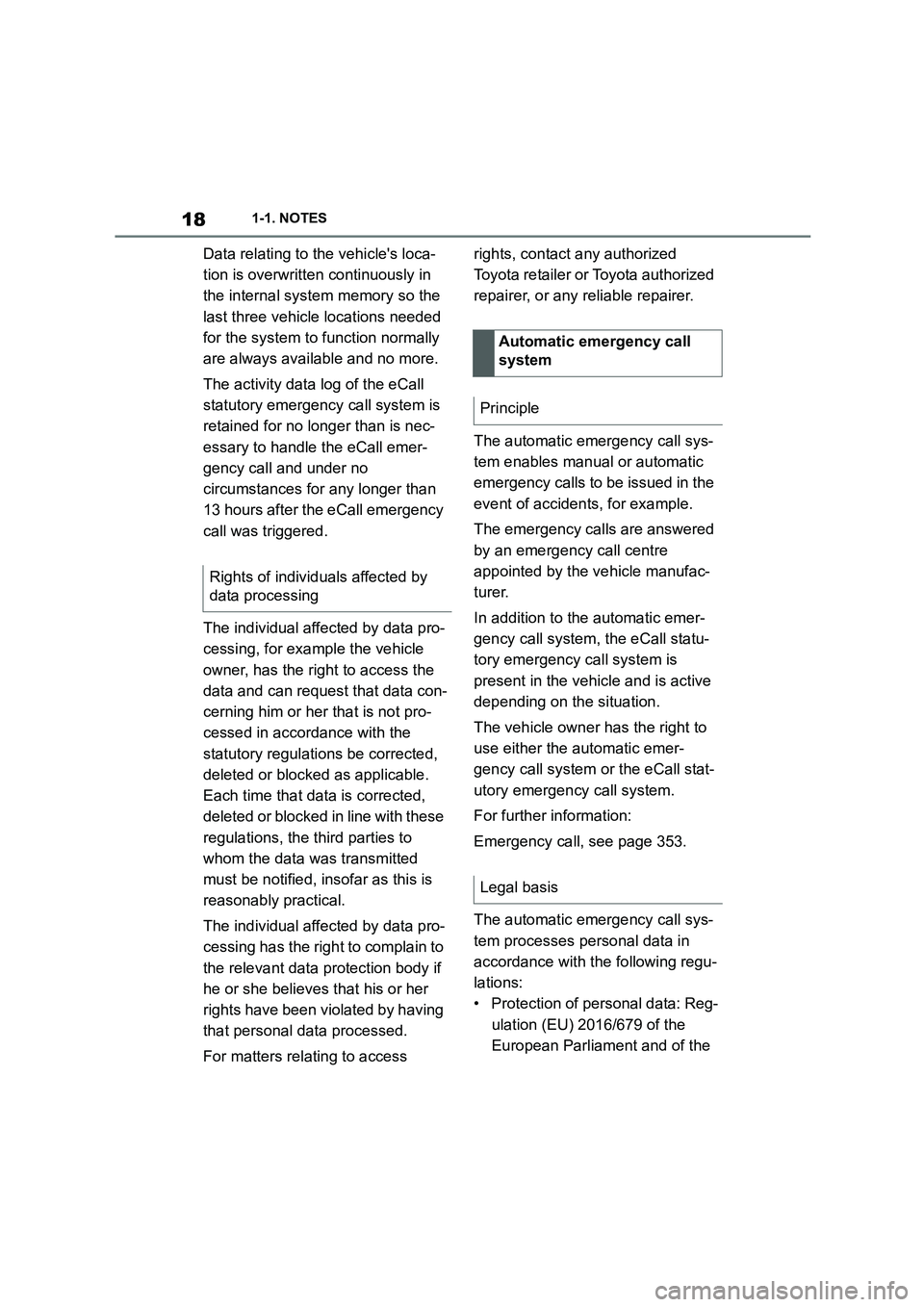
181-1. NOTES
Data relating to the vehicle's loca-
tion is overwritten continuously in
the internal system memory so the
last three vehicle locations needed
for the system to function normally
are always available and no more.
The activity data log of the eCall
statutory emergency call system is
retained for no longer than is nec-
essary to handle the eCall emer-
gency call and under no
circumstances for any longer than
13 hours after the eCall emergency
call was triggered.
The individual affected by data pro-
cessing, for example the vehicle
owner, has the right to access the
data and can request that data con-
cerning him or her that is not pro-
cessed in accordance with the
statutory regulations be corrected,
deleted or blocked as applicable.
Each time that da ta is corrected,
deleted or blocked in line with these
regulations, the third parties to
whom the data was transmitted
must be notified, insofar as this is
reasonably practical.
The individual affected by data pro-
cessing has the righ t to complain to
the relevant data protection body if
he or she believes that his or her
rights have been violated by having
that personal data processed.
For matters relating to access
rights, contact any authorized
Toyota retailer or Toyota authorized
repairer, or any reliable repairer.
The automatic emergency call sys-
tem enables manual or automatic
emergency calls to be issued in the
event of accidents, for example.
The emergency calls are answered
by an emergency call centre
appointed by the vehicle manufac-
turer.
In addition to the automatic emer-
gency call system, the eCall statu-
tory emergency call system is
present in the vehicle and is active
depending on the situation.
The vehicle owner has the right to
use either the automatic emer-
gency call system or the eCall stat-
utory emergency call system.
For further information:
Emergency call, see page 353.
The automatic emergency call sys-
tem processes personal data in
accordance with the following regu-
lations:
• Protection of personal data: Reg-
ulation (EU) 2016/679 of the
European Parliament and of the
Rights of individuals affected by
data processing
Automatic emergency call
system
Principle
Legal basis
Page 25 of 498
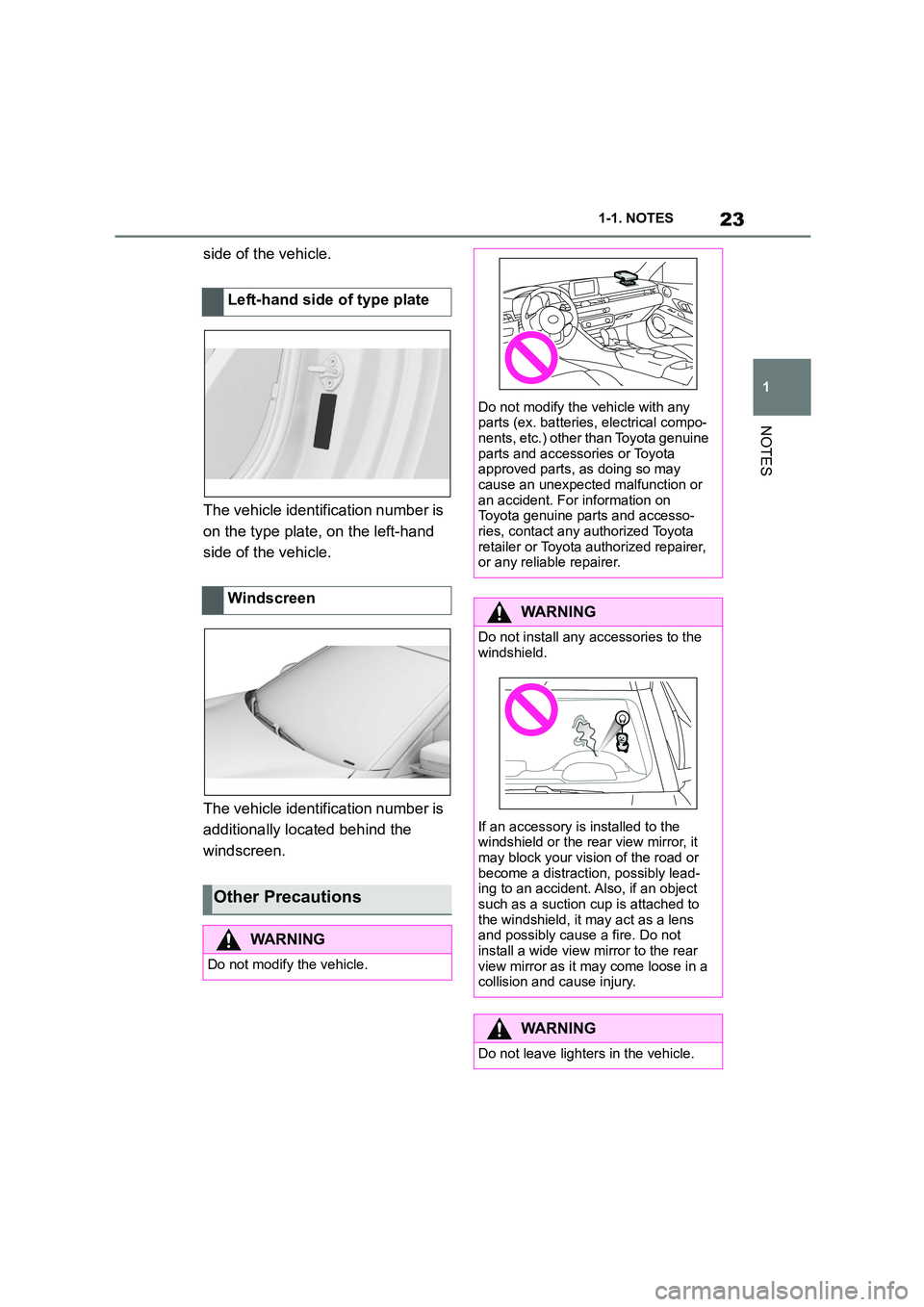
23
1
1-1. NOTES
NOTES
side of the vehicle.
The vehicle identification number is
on the type plate, on the left-hand
side of the vehicle.
The vehicle identification number is
additionally located behind the
windscreen.
Left-hand side of type plate
Windscreen
Other Precautions
WA R N I N G
Do not modify the vehicle.
Do not modify the vehicle with any parts (ex. batteries, electrical compo-
nents, etc.) other than Toyota genuine
parts and accessories or Toyota approved parts, as doing so may
cause an unexpected malfunction or
an accident. For information on Toyota genuine parts and accesso-
ries, contact any authorized Toyota
retailer or Toyota authorized repairer, or any reliable repairer.
WA R N I N G
Do not install any accessories to the
windshield.
If an accessory is installed to the
windshield or the rear view mirror, it
may block your vision of the road or become a distraction, possibly lead-
ing to an accident. Also, if an object
such as a suction cu p is attached to the windshield, it may act as a lens
and possibly cause a fire. Do not
install a wide view mirror to the rear view mirror as it may come loose in a
collision and cause injury.
WA R N I N G
Do not leave lighters in the vehicle.
Page 30 of 498
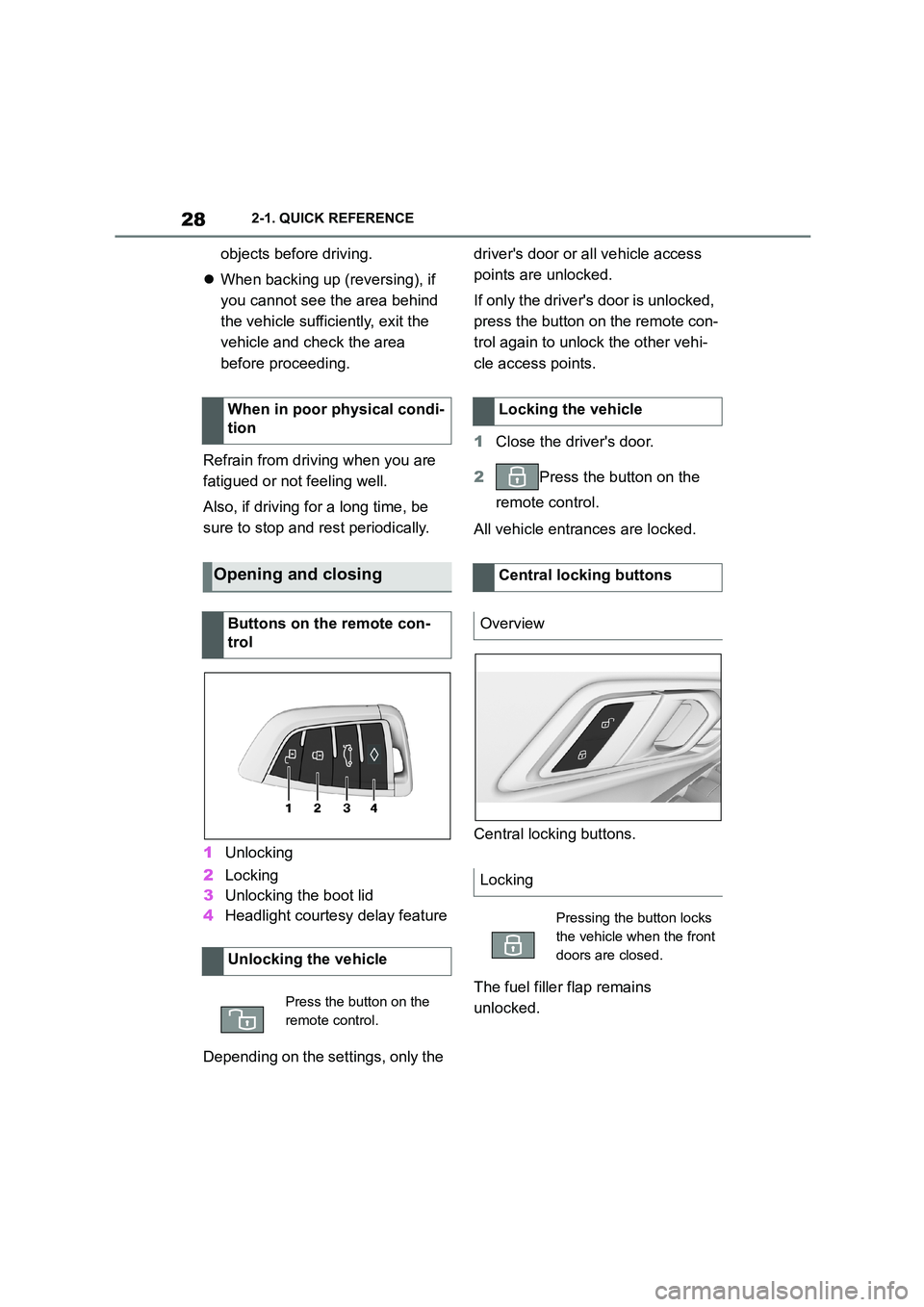
282-1. QUICK REFERENCE
objects before driving.
When backing up (reversing), if
you cannot see the area behind
the vehicle sufficiently, exit the
vehicle and check the area
before proceeding.
Refrain from driving when you are
fatigued or not feeling well.
Also, if driving for a long time, be
sure to stop and rest periodically.
1 Unlocking
2 Locking
3 Unlocking the boot lid
4 Headlight courtesy delay feature
Depending on the settings, only the
driver's door or all vehicle access
points are unlocked.
If only the driver's door is unlocked,
press the button on the remote con-
trol again to unlock the other vehi-
cle access points.
1 Close the driver's door.
2 Press the button on the
remote control.
All vehicle entrances are locked.
Central locking buttons.
The fuel filler flap remains
unlocked.
When in poor physical condi-
tion
Opening and closing
Buttons on the remote con-
trol
Unlocking the vehicle
Press the button on the
remote control.
Locking the vehicle
Central locking buttons
Overview
Locking
Pressing the button locks
the vehicle when the front
doors are closed.
Page 31 of 498
29
2
2-1. QUICK REFERENCE
QUICK REFERENCE
This feature allows you to access
the vehicle without having to oper-
ate the remote control.
Simply having the remote control
with you, for example in your trou-
ser pocket, is sufficient.
The vehicle automatically recog-
nises the remote control when it is
in the immediate vicinity or inside
the vehicle.
Fully grip the handle of a vehicle
door.
With the doors closed, touch the
indentation (lock sensor) on the
door handle with a finger for
approximately 1 second.
Press and hold the button on
the remote control for approxi-
mately 1 second. Depending on the
setting, the doors may also unlock,
see page 100.
Close the boot lid manually.
Unlocking
Pressing button unlocks
vehicle.
Smart Key System
Principle
Unlocking the vehicle
Locking the vehicle
Boot lid
Opening
Closing
Page 32 of 498
302-1. QUICK REFERENCE
1Wipers
2 Instrument cluster
3 Turn indicator, high-beam head-
lights
4 Light switch element
Indicator and warning lamps can
illuminate in a variety of combina-
tions and colours.
When the engine starts or the
standby state is switched on, the
functionality of some lights is briefly
checked.
1 Exterior mirrors
2 Power window switches
3 Central locking system
4 Unlocking the boot lid
1 Selector lever
2 Controller
3 Auto Start & Stop cancel button
4 Sport mode switch
5 Park Assistant button
6 VSC OFF button
7 Toyota Supra Safety button
8 Parking brake
Toyota Supra Command brings
together the functions of a number
of switches. These functions can be
operated using the Controller and,
depending on the equipment ver-
sion, the touchscreen.
Displays and controls
Around the steering wheel
Indicator and warning lamps
Driver's door
1
2
3
4
321
4
Switch cluster
Toyota Supra Command
Principle
Page 39 of 498
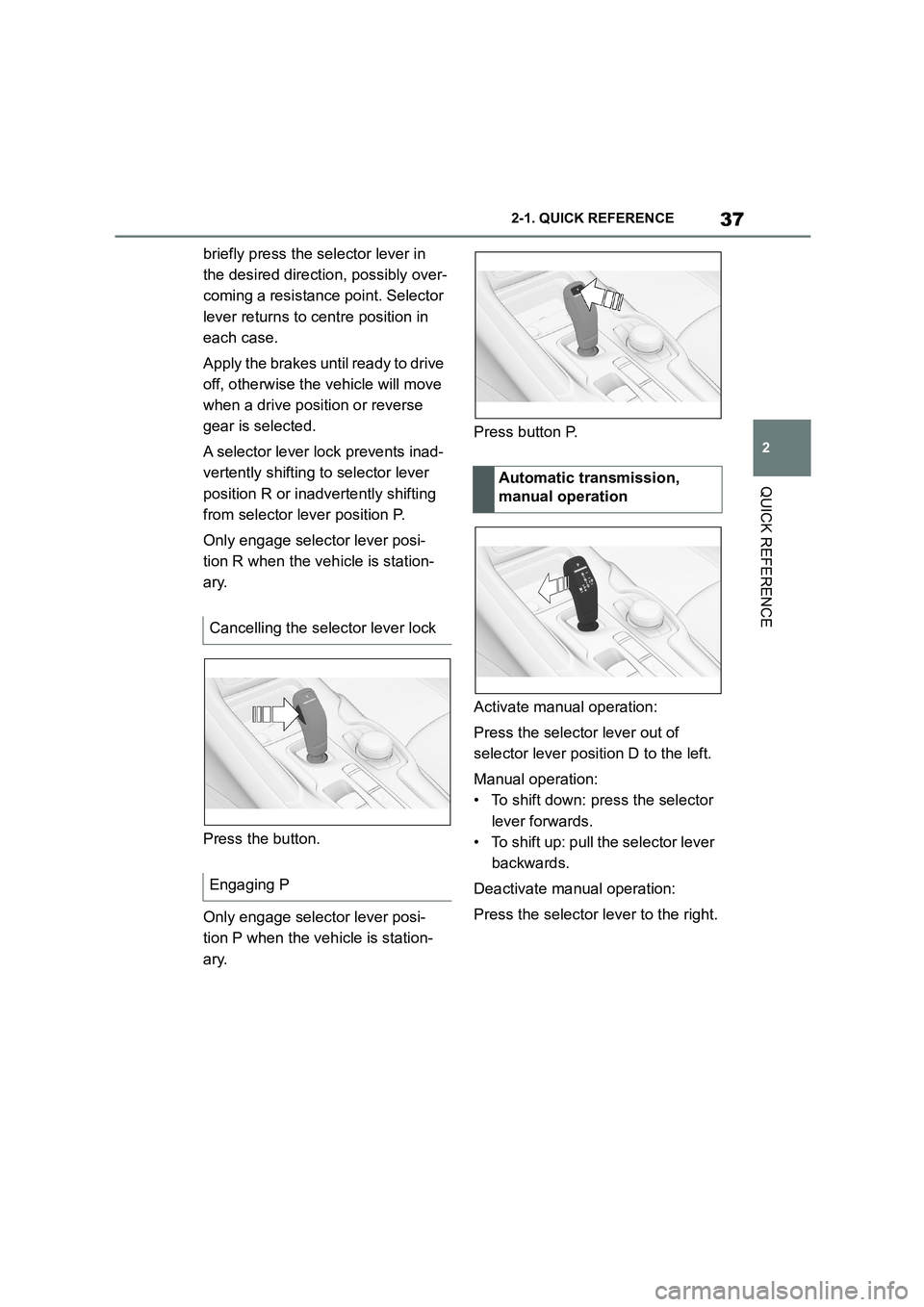
37
2
2-1. QUICK REFERENCE
QUICK REFERENCE
briefly press the se lector lever in
the desired direction, possibly over-
coming a resistance point. Selector
lever returns to centre position in
each case.
Apply the brakes until ready to drive
off, otherwise the vehicle will move
when a drive position or reverse
gear is selected.
A selector lever lock prevents inad-
vertently shifting to selector lever
position R or inadvertently shifting
from selector lever position P.
Only engage selector lever posi-
tion R when the vehicle is station-
ary.
Press the button.
Only engage selector lever posi-
tion P when the vehicle is station-
ary.
Press button P.
Activate manual operation:
Press the selector lever out of
selector lever position D to the left.
Manual operation:
• To shift down: press the selector
lever forwards.
• To shift up: pull the selector lever
backwards.
Deactivate manual operation:
Press the selector lever to the right.
Cancelling the selector lever lock
Engaging P
Automatic transmission,
manual operation
Page 42 of 498
402-1. QUICK REFERENCE
Pull the wiper lever.
1 Tap the rear edge of the fuel
filler flap to open it.
2 Turn the fuel tank cap anticlock-
wise.
3 Place the fuel tank cap in the
holder on the fuel filler flap.
For optimal fuel consumption, the
petrol should be sulphur-free or low
Air conditioning
ButtonFunction
Temperature.
Recirculated-air mode.
Maximum cooling.
AUTO program.
Air distribution, manual.
Switching off.
Defrost and defog the
windshield.
Rear window defroster.
Seat heating.
Climate control operation.
Air flow, manual.
Refuelling stop
Refuelling
Fuel tank cap
Petrol
ButtonFunction
Page 45 of 498
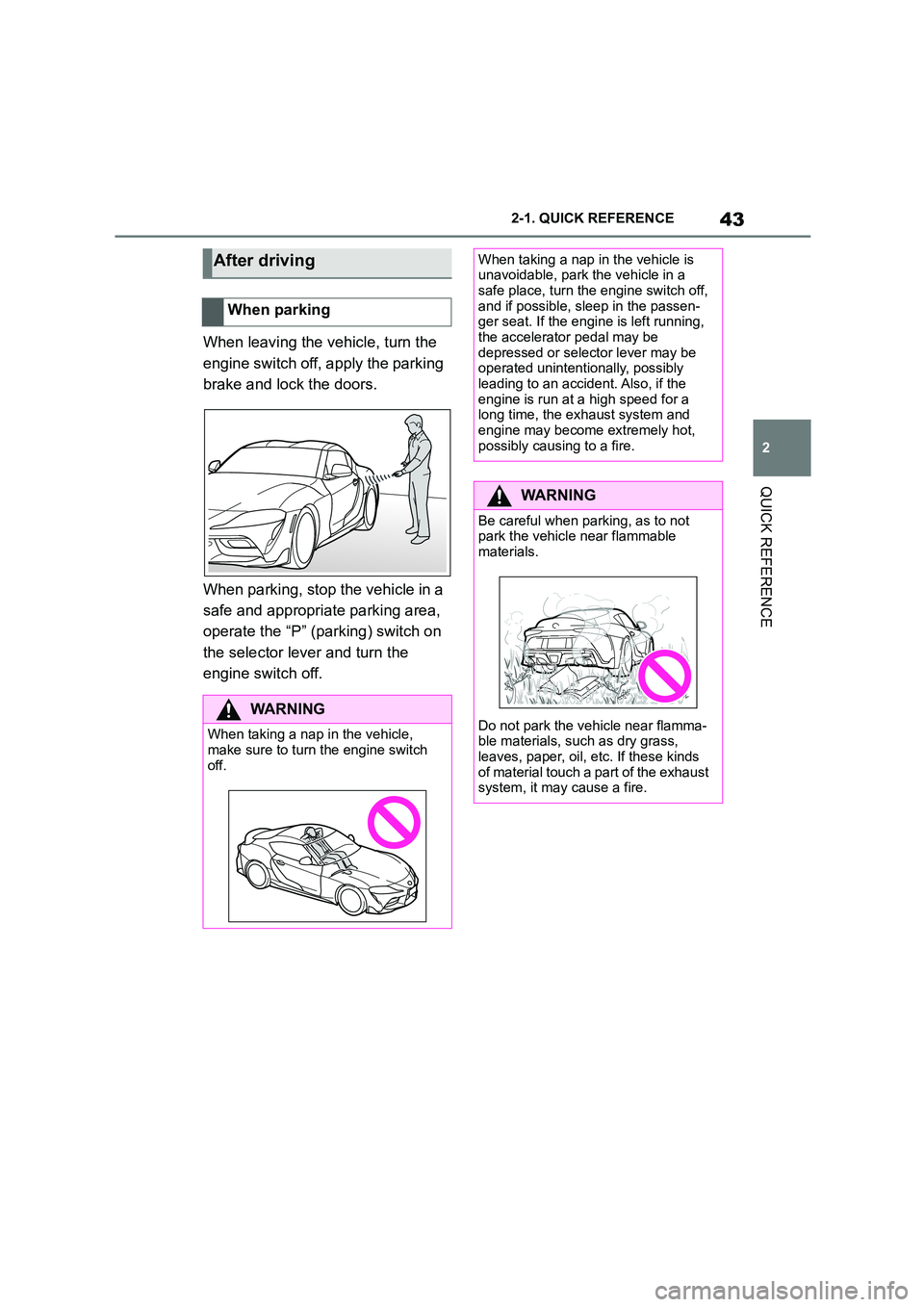
43
2
2-1. QUICK REFERENCE
QUICK REFERENCE
When leaving the vehicle, turn the
engine switch off, apply the parking
brake and lock the doors.
When parking, stop the vehicle in a
safe and appropriate parking area,
operate the “P” (parking) switch on
the selector lever and turn the
engine switch off.
After driving
When parking
WA R N I N G
When taking a nap in the vehicle,
make sure to turn the engine switch off.
When taking a nap in the vehicle is unavoidable, park the vehicle in a
safe place, turn the engine switch off,
and if possible, sleep in the passen- ger seat. If the engine is left running,
the accelerator pedal may be
depressed or select or lever may be operated unintentionally, possibly
leading to an accident. Also, if the
engine is run at a high speed for a long time, the exhaust system and
engine may become extremely hot,
possibly causing to a fire.
WA R N I N G
Be careful when parking, as to not park the vehicle near flammable
materials.
Do not park the vehicle near flamma-
ble materials, such as dry grass,
leaves, paper, oil, etc. If these kinds of material touch a part of the exhaust
system, it may cause a fire.